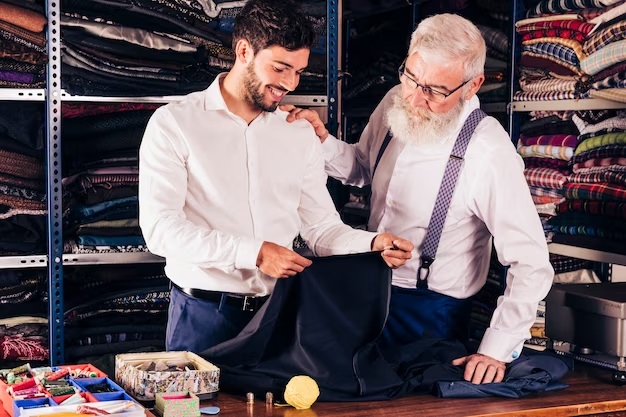A well-tailored suit enhances personal style, showcasing professionalism and a keen eye for detail. It projects confidence and competence, making it a critical wardrobe piece for business and formal affairs. Indeed, investing in a bespoke suit is investing in personal presentation.
A bespoke suit from a Bespoke tailor in Singapore is designed according to an individual’s specifications and measurements. The process involves multiple fittings, hand-sewn craftsmanship, and a wide selection of high-quality fabrics to ensure an exact fit and unique style.
The Process of Getting a Bespoke Suit
Initial consultation with tailor
During an initial consultation with a tailor, measurements are taken and style preferences are discussed. The tailor provides expert advice on fabrics and fits catering to your personal taste. This meeting sets the foundation for your bespoke clothing piece, ensuring a perfect end result.
Selection of fabric and design
Choosing the right fabric and design is crucial for any garment. Fabric must be durable, comfortable, and suitable for the desired style. Additionally, the design should be aesthetically appealing, functional, and cater to the client’s personal taste and lifestyle.
Body measurements
Body measurements are essential for determining clothing sizes, monitoring growth, and assessing health status. They include measurements such as height, weight, waist, hip, and chest size. These can be tracked over time for fitness or health purposes, ensuring the right fit and wellness.
Fitting sessions
Fitting sessions are crucial in fashion designing, ensuring that the final garment fits the model or client perfectly. It involves adjusting sizes, making necessary changes in the design, and confirming the comfort and style of the outfit.
The Benefits of a Bespoke Suit
Perfect fit
“Perfect fit” can define a seamless blend of form and function. It could refer to clothing tailored to complement a specific person’s figure, a career that matches an individual’s interests and strengths, or even relationships that exist harmoniously due to shared values and affection.
High-quality materials
High-quality materials are essential for both durability and aesthetics in products. They withstand wear and tear while maintaining their appearance. Such materials include high-grade steel, premium leather, and fine ceramics, all used to create exceptional, reliable, and visually appealing products.
Personalized style and design
Personalized style and design reflect an individual’s unique taste and personality. It is the culmination of personal preference, inspiration, and creativity. A tailored approach in both fashion and interior design, can result in distinctive and authentic expressions of one’s self.
Durability and longevity
Durability and longevity are critical factors when assessing the quality of a product. Durable items can resist wear, pressure, or damage, thus increasing their lifespan. High durability usually assures longevity, offering users longer service or usage, which results in cost-effectiveness.
Factors to Consider in Choosing a Bespoke Tailor
Reputation
Reputation is an integral entity both in personal and business affairs. It signifies the perceived quality of one’s character or business based on past actions or achievements. A strong, positive reputation can open doors to opportunities and potential success.
Expertise and skill levels
Expertise and skill levels distinguish professionals in any field. Higher skill levels are attained through rigorous training, experience, and practice. Expertise often denotes specialization, demonstrating superior knowledge or skills in a particular area. Both significantly impact performance and outcomes.
Variety of fabric options
There is a vast variety of fabric options available for different purposes. Each fabric, be it silk, cotton, linen, or wool, has unique properties. They cater to various needs, such as comfort, durability, and aesthetic appeal, satisfying diverse fashion and home décor requirements.
Price range
The price range refers to the difference between the highest and lowest prices for an item, service, or commodities in a market. It enables consumers to budget effectively, and vendors to strategize their pricing in relation to market trends and competition.
Prominent Bespoke Tailors Around the World
Savile Row in London
Savile Row in London is internationally renowned for its high-quality bespoke tailoring. Established in the 18th century, the elegant street exudes old-world charm and craftsmanship, gracefully maintaining its reputation as a hub for custom-made menswear.
Hong Kong’s custom tailors
Hong Kong’s custom tailors are world-renowned, offering exceptional quality and detail in their craftsmanship. They employ traditional tailoring techniques, providing uniquely personal service and perfectly fitted garments. These bespoke pieces are popular with locals and international clientele alike.
Neapolitan tailors in Italy
Neapolitan tailors in Italy are renowned for their distinct style and precision. Rooted in generations of craftsmanship, they create bespoke clothing, mirroring Naples’ vibrant culture. Their work, embodying elegance and comfort, contributes significantly to Italy’s global sartorial reputation.
Care and Maintenance of a Bespoke Suit
Proper storage
Proper storage is crucial for maintaining the quality and longevity of items. Whether storing food, clothing, documents or electronics, each requires specific conditions. Correct storage prevents damage, spoilage and loss, ultimately saving time and money in replacements.
Cleaning recommendations
Regular cleaning lowers the presence of bacteria and viruses, creating a healthier environment. It’s recommended to focus on high-touch surfaces such as doorknobs, light switches, and smartphones. Always use approved disinfectants and follow manufacturer’s instructions for safety and effectiveness.
Repair and alterations
Repair and alterations are essential services that maintain and enhance the longevity of items, particularly clothing and buildings. They involve fixing damages, adapting structures and restyling garments to improve functionality, aesthetics, safety, or to cater to changing needs and preferences.
